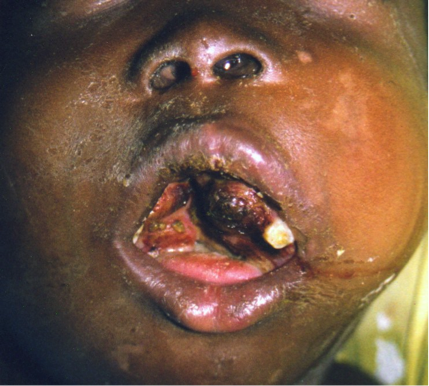WBR0248
| Author | [[PageAuthor::Rim Halaby, M.D. [1] (Reviewed by Yazan Daaboul, M.D.)]] |
|---|---|
| Exam Type | ExamType::USMLE Step 1 |
| Main Category | MainCategory::Pathology |
| Sub Category | SubCategory::Hematology |
| Prompt | [[Prompt::A 6-year-old African boy is brought to the physician's office for a growing lesion in his jaw. Upon review of systems, the mother explains that her child has been having night sweats and weight loss. The family recently immigrated from Africa, and the patient did not receive medical care prior to the family's arrival to USA. Physical examination is remarkable for a jaw lesion with severe orofacial and teeth disruption (shown below). The child’s condition is caused by dysregulation of which gene? |
| Answer A | AnswerA::''L-MYC'' |
| Answer A Explanation | AnswerAExp::The ''L-MYC'' oncogene is associated with lung cancers. |
| Answer B | AnswerB::''RET'' |
| Answer B Explanation | [[AnswerBExp::The RET oncogene is associated with multiple endocrine neoplasia (MEN) syndromes type 2A and 2B.]] |
| Answer C | AnswerC::''N-MYC'' |
| Answer C Explanation | [[AnswerCExp::N-MYC oncogene is associated with neuroblastoma.]] |
| Answer D | AnswerD::''HER2'' |
| Answer D Explanation | [[AnswerDExp::HER2 oncogene is associated with breast, ovarian, and gastric cancers.]] |
| Answer E | AnswerE::''C-MYC'' |
| Answer E Explanation | [[AnswerEExp::C-MYC oncogene is associated with Burkitt's lymphoma.]] |
| Right Answer | RightAnswer::E |
| Explanation | [[Explanation::Burkitt's lymphoma is an aggressive B-cell non-Hodgkin's lymphoma caused by a translocation that results in the expression of the C-MYC oncogene, a transcription factor that has a role in the regulation of cell cycle. The tumor has been associated with the translocation t(8;14) among the majority of cases (85%) and translocations t(2;8) or t(8;22) in fewer than 20% of cases. Burkitt's lymphoma is characterized by a high proliferative potential and rapid turnover with a doubling time that is as fast as 24-48 hours. It is considered to be one of the fastest growing tumors. Burkitt's lymphoma is also the first malignancy to be associated with a virus, where EBV has been observed to have a direct causative role in the development of the tumor by immortalising B-cells.
Burkitt's lymphoma is common among children. It is classified into 3 types based on the geographical distribution, its association with infectious agents, and clinical presentation: The sporadic type is the most common type in USA and Europe and is rarely associated with EBV. It usually manifests with an abdominal or pelvic tumor; and patients typically complain of vague abdominal pain, nausea, and early satiety. The endemic type is common in regions with malaria endemicity (e.g. central Africa) and has been associated with EBV in almost all cases. Manifestations of endemic-type Burkitt's lymphoma usually include jaw or periorbital swelling, especially among children between the age 3 to 7 years. Finally, the immunodeficiency-type is common among patients with early HIV infection (CD4 > 200 cells/mm3). In this vignette, the patient is most likely diagnosed with endemic-type Burkitt's lymphoma given his age, his recent immigration from Africa, and the location of his tumor involving the jaw. On histopathological analysis, Burkitt's lymphoma appears as monomorphic, medium-sized cells that have a high rate of turnover. A "starry sky" appearance is observed due to the presence of apoptotic tumor cells within tingible-body-laden macrophages on microscopy. Tumor cells are usually B-cells that express CD10, CD20, and CD79a. EBV RNA may also be expressed and identified on fluorescence in-situ hybridisation (FISH). The prognosis of Burkitt's lymphoma is mainly based on the stage of the tumor at diagnosis. Treatment of localized disease consists of surgical resection and chemotherapy, whereas more advanced cases require chemotherapy only. |
| Approved | Approved::Yes |
| Keyword | WBRKeyword::Burkitt's lymphoma, WBRKeyword::C-myc, WBRKeyword::Oncogene, WBRKeyword::Hematologic malignancy, WBRKeyword::Translocation, WBRKeyword::Transcription factor |
| Linked Question | Linked:: |
| Order in Linked Questions | LinkedOrder:: |
